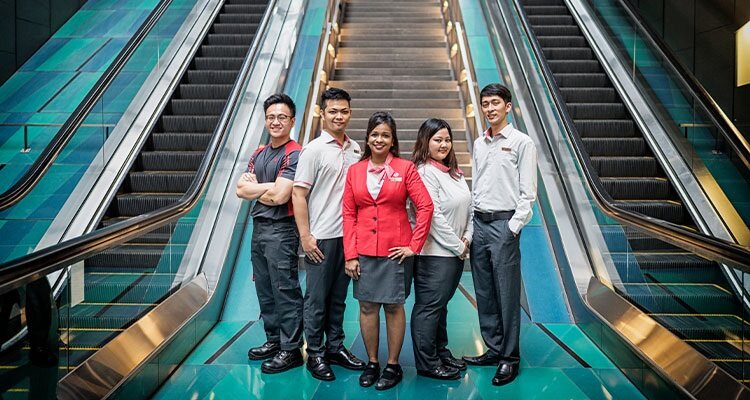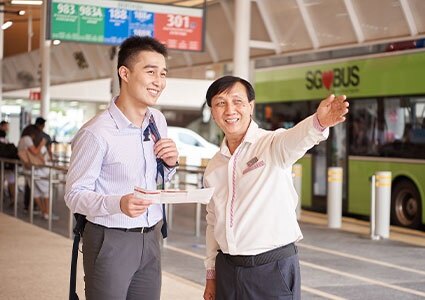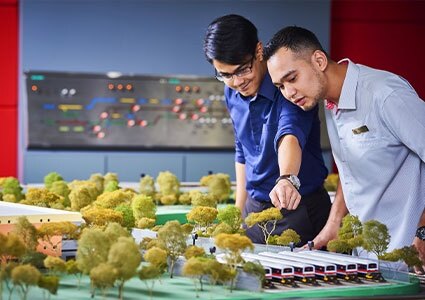
How STRIDES is driving urban mobility through digitalization, decarbonization and demand
As a business arm of SMRT Corporation Ltd, STRIDES capitalizes on its capabilities as Singapore’s pioneering public transport operator. Leveraging over 40 years of experience operating and maintaining major public transport infrastructure at home and abroad, the organization provides multi-modal urban mobility solutions and services that deliver safe, reliable and comfortable journeys, alongside exceptional experiences.
 Lee Ling Wee, Deputy Group CEO of SMRT Corporation and President of STRIDES International Business, joins us to share STRIDES’ story. “SMRT’s establishment coincided with the launch of the first metro system in Singapore, and in a way, we very much represent metro services in Singapore,” he begins. “Our competencies were initially invested in the metro service, but later, we acquired a bus company and became multimodal. The business operates both publicly and commercially. In terms of public transport, the metro, bus, and automotive services, this operational arm is regulated by the government. Whereas our commercial business is split into two offerings.
Lee Ling Wee, Deputy Group CEO of SMRT Corporation and President of STRIDES International Business, joins us to share STRIDES’ story. “SMRT’s establishment coincided with the launch of the first metro system in Singapore, and in a way, we very much represent metro services in Singapore,” he begins. “Our competencies were initially invested in the metro service, but later, we acquired a bus company and became multimodal. The business operates both publicly and commercially. In terms of public transport, the metro, bus, and automotive services, this operational arm is regulated by the government. Whereas our commercial business is split into two offerings.
“One is Stellar Lifestyle, the largest managing agent of retail and advertising spaces in Singapore. It is focused on the expansion of our retail and media synergies to build an ecosystem with capabilities driven by digital innovation. We support SMEs and placemaking developments in and around our transit network to strengthen the experience of the communities we serve. Stellar Lifestyle provides services that include retail mall management, outdoor media, digital advertising solutions, and digital engagement platforms. In line with our vision of ‘Moving People, Enhancing Lifestyles’, the commuter experience forms the cornerstone of Stellar Lifestyle’s operations, bringing convenience and community to our transport nodes.
The other commercial business is STRIDES, which encompasses rail, mobility, green tech, and engineering. In terms of rail, STRIDES offers extensive experience in operations, maintenance and service (OMS), transport planning, as well as strong engineering capabilities. Its expertise in customizing end-to-end design-build-operate-maintain-transfer solutions and services have delivered reliable, and safe journeys.
Sustainable services
STRIDES is also a leading mobility solutions and services provider. Operating and maintaining a wide and diverse fleet, it connects customers, drivers and vehicles to deliver technology-enabled solutions that are safe, reliable, inclusive and sustainable.
The company’s green tech offering provides innovative, sustainable, and digital mobility solutions. Collaborating with leading industry players, it offers a wide range of customer-focused solutions to help accelerate adoption of green mobility. Whether a large corporation or small business, clients can benefit from the company’s expertise to reduce carbon footprint and improve operational agility.
STRIDES engineering boasts experience in advanced innovative technologies, as well as digital solutions and services, continuing to design solutions to solve both current and future challenges of urban transport to drive safety, reliability, comfort and customer experience.
Alongside its programs of continuous line improvements and expansions, STRIDES places increasing importance on sustainable operations. “We are striving to achieve Net Zero by 2050,” Lee continues. “At a national level, train transport is the most sustainable way to travel. We encourage commuters to convert from private to public transport and it’s important for us to play our part in making sure that the service we provide is an excellent one. Customer service and experience must be such that it encourages the modal shift.
“Over the years, as the government increasingly builds metro lines, we are progressively increasing our share of public transport. That expansion alone plays an important part in moving towards achieving Net Zero. From solar panel installations at depots and stations to improving signaling systems to optimize the use of electricity, we’re also exploring how we can better manage our operational spaces. We are also innovating our green communication-based train control (CBTC) system, examining how we can control the trains to avoid unnecessary acceleration, for example. If we can save even ten percent of the energy we use, that is still a significant outcome,” he elaborates.
Service best practice
Looking to the company’s wider services, Lee shares that the business is always striving for enhanced reliability. “We have implemented metrics to measure our reliability performance. Over the years, the number of instances of over five minutes’ delay has drastically reduced. We leverage digital technologies to drive condition-based and predictive maintenance. From obstructions to mechanical faults, sensors pick up anomalies and alert our engineers. We use technology to learn from events and try to prevent recurrences and this extends to our Operational Control Center (OCC). We’re teaching our systems to be alert to situations such as overcrowding or passenger difficulties that may cause delays, sending signals to our controllers to react accordingly. We have replicated this technology, and it pretty much operates in real time to provide a bigger, operational picture and total situational awareness.” 
Lee goes on to share some of the organization’s recent investments and developments, designed to enhance the commuter experience beyond reliability. “In our push towards our vision of Moving People, Enhancing Lifestyles, we are driven to revitalize our commuters’ experience. Our Go-To SMRT initiative has been fully rolled out at 98 MRT stations and four bus interchanges. Commuters who need help with wayfinding, first aid, locating missing persons, or who require specialized support, may approach our station staff for assistance. Our station staff have undergone training to help commuters with special needs such as dementia. Our digital concierge service has also been enhanced to provide commuters with clear and user-friendly travel information, including maps of stations with directions to frequently-asked-for amenities, and alternative transport information.
“Since 2020, the Singapore Airlines Experiential Training has been a continual service training initiative that we have co-created in partnership with the Singapore Airlines Academy so that we can learn from the best,” Lee continues. “Last year, 80 of our Train Captains and Rovers attended the experiential training program and learnt the importance of having a safety-first and service-oriented mindset and the importance of professional image from experienced pilots and the academy lecturers. Prior to sending our Train Captains and Rovers for this training, our frontline station colleagues were the first group of participants to be trained by senior cabin crew of the academy. They learnt the best practices in service and how to deliver going-the-extra-mile services to our commuters.
“To complement this service, the company has introduced the WINK+ commuter app, enabling both locals and tourists to better navigate the vibrant streets of Singapore and discover ýÞÊâèÌ乐 (home, travel, eat, shop, and play) offerings near our stations and interchanges. We seek to better understand our commuters’ needs through feedback channels and surveys. For instance, a pain point we identified from the survey was a difficulty finding clean and available restrooms in and around our stations. To address this, we developed a Restroom Guide for Commuters, reducing the time needed to locate a restroom with effective wayfinding information. We have also rolled out other initiatives like our Makan (Food) Guide, and gamified experiences such as Wink Hunt with attractive prizes to be won,” he elaborates.
Continuous improvement
Another focus for the organization is staff training and green harvesting by working with tertiary institutions to foster the next generation of mobility professionals. “SMRT aims to shape a skilled and future-ready workforce that will drive innovation and excellence in the rail industry and continue to build a sustainable and thriving public transport ecosystem for the benefit of all. We are also facilitating knowledge exchange by offering attachment opportunities for polytechnic lecturers at SMRT. This allows them to gain firsthand insights into the industry’s needs and challenges, fostering a stronger alignment between academia and industry practices.
Looking to the future, Lee highlights that alongside recent innovations the business will be focusing on the timely delivery of its current projects and lines. “We want to make sure we’re doing a good job and delivering on our promises. Our focus will still be on our core service, which is public transport. We adopted the Kaizen framework, which ensures continuous improvement. It is only by doing well, reinventing ourselves, and innovating with new ideas that we can stay ahead of the game. Maybe in five years’ time, we will have had to come up with something new, something better to optimize our services. We will continue to do all we can to better serve our clients. It’s a fast-changing world. You never know what will happen, so it’s crucial to stay relevant,” he concludes.